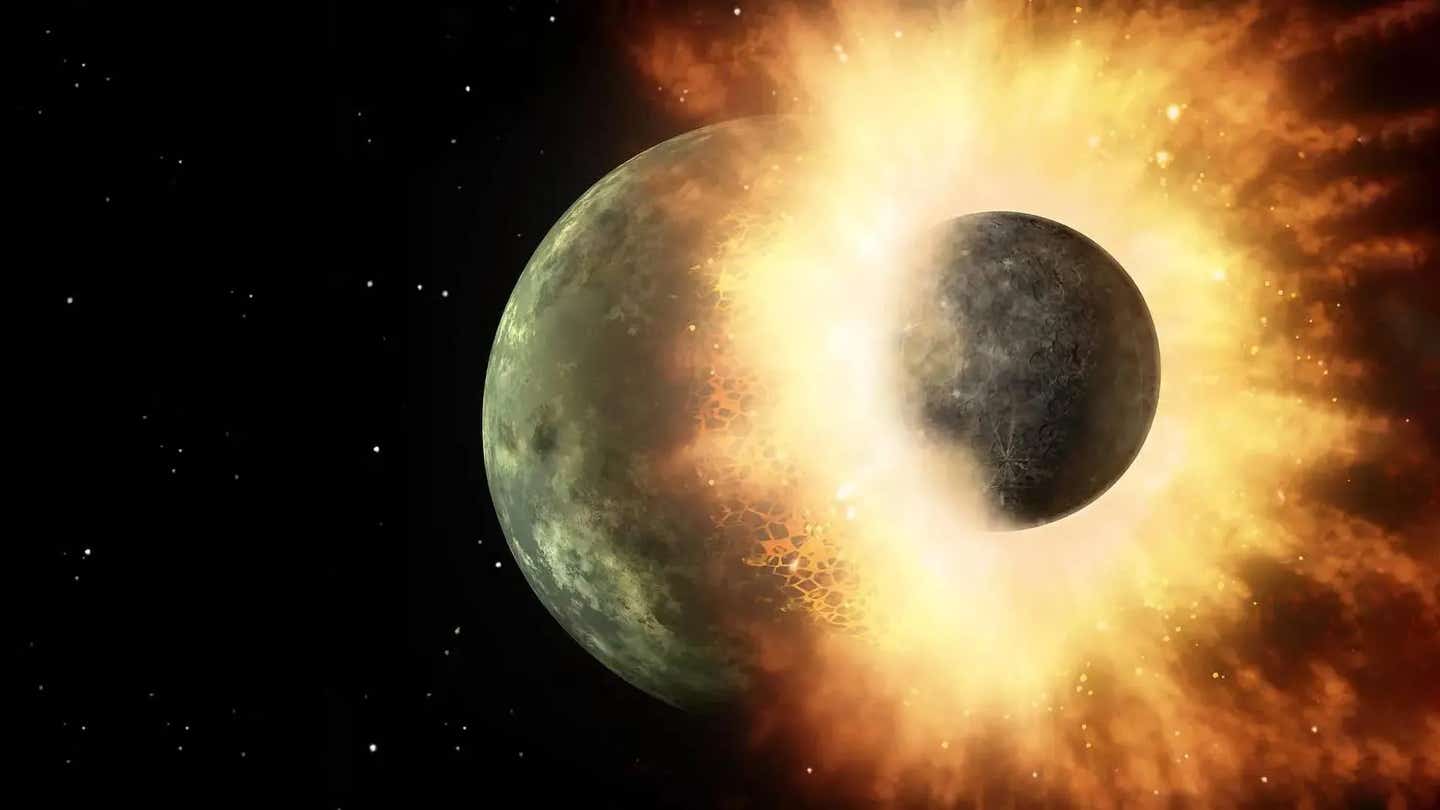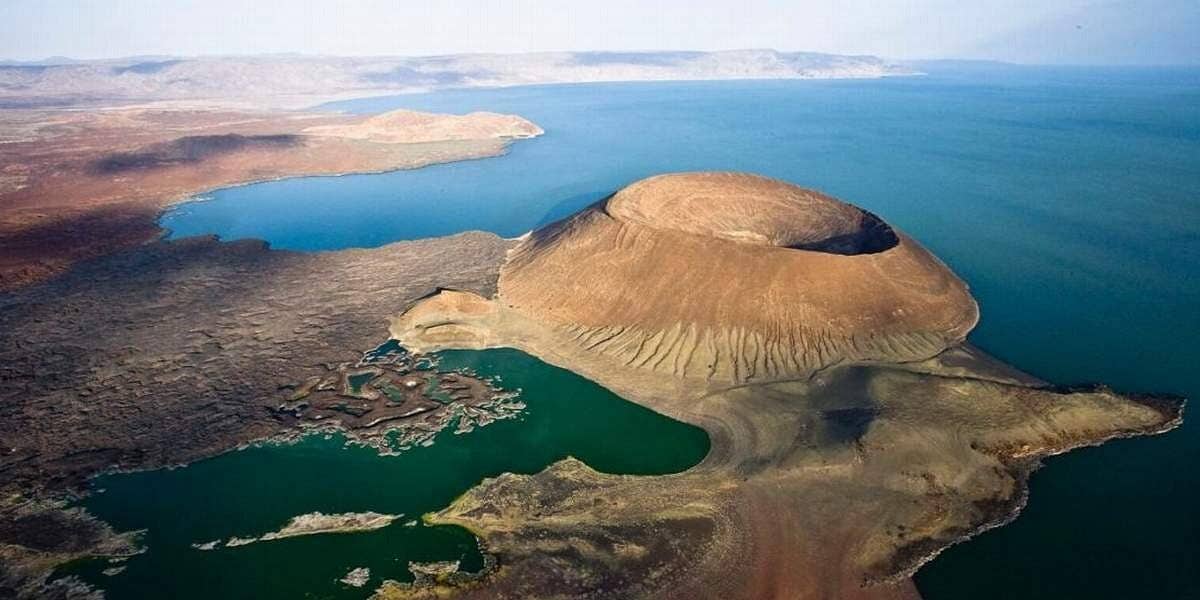How a planetary crash with Theia brought water and life to Earth
Earth’s chemistry formed within 3 million years, but a later collision likely brought the water that made life possible.

Earth’s chemical makeup solidified just three million years after the Solar System formed—yet it was a later collision with another planet that likely made Earth habitable. (CREDIT: NASA/JPL-Caltech)
About 4.6 billion years ago, the Solar System formed from a cloud of dust and gas collapsing in on itself due to gravity. The Sun, planets, and eventually Earth formed out of the cloud. But when did our planet inherit the chemical formula that characterizes it—and when did it become habitable?
In a new paper by scientists at the University of Bern, the chemical signature of Earth was solidified a great deal earlier than scientists had thought before—in merely three million years of the Solar System's creation. That's amazingly fast on cosmic timescales.
Maybe more surprisingly though, the early planet was arid and lifeless. The raw materials for life, including water and carbon chemistry, most likely arrived much later—are brought by a cataclysmic collision with another world-sized body called Theia.
Timing Earth's Chemical "Fingerprint"
The research used isotope analysis and computer modeling to try to reconstruct how Earth's chemistry evolved. The scientists, led by Dr. Pascal Kruttasch, a postdoctoral fellow at Imperial College London, examined the ratio of manganese (Mn) to chromium (Cr) in meteorites and rocks on Earth. They used an atomic clock of a kind based on radioactive decay of manganese-53 (^53Mn), which turns into chromium-53 (^53Cr) in about 3.8 million years.
This isotopic degradation gives scientists an incredibly accurate way to quantify when different materials were formed and when they stopped changing. "These measurements were possible because the University of Bern has world-class expertise in the analysis of extraterrestrial materials," explained co-author Klaus Mezger, Professor Emeritus of Geochemistry at Bern's Institute of Geological Sciences.
Their results suggest that by three million years into Solar System formation, the ancestor of Earth—the proto-Earth—had already gained its final chemical composition. That composition was surprisingly devoid of easily evaporated volatile elements like water, carbon, and sulfur. That is, the planet's chemistry was established well ahead of time for it to have the raw materials of life.
A Dry Beginning in a Hot Neighborhood
The reason behind Earth's early dryness is in its origin. The inner Solar System in which Earth, Venus, and Mars formed was too hot for most volatile components to freeze out of a gaseous phase into a solid phase. These compounds were evaporated and did not enter the rocky material that built the terrestrial planets.
Meanwhile, bodies that had formed farther from the Sun—like Jupiter and Saturn's ice moons—had preserved much more water and carbon.
By comparing Earth's isotopic signature to meteorites from the outer Solar System, they found that the proto-Earth's chemistry had been volatilized stripped in its first three million years. It was a rock, barren embryo—its chemical personality set, but without the building blocks of life.
The Cosmic Collision That Changed Everything
If the Earth began as a dry rock, how did it end up as the blue planet of today? The answer, the scientists argue, is in a monumental event that occurred tens of millions of years later—a monstrous collision with an object roughly the size of Mars.
That impactor, Theia, would have originated from a cooler region nearer the outer parts of the solar system, where volatile components were more concentrated. That proto-Earth/Theia collision is already thought to have created the Moon. And now, isotope data suggests that it may have delivered water and other life-necessary elements to the surface of Earth as well.
"Because of our results, we're sure proto-Earth was initially a dry rocky body," Kruttasch added. "It can therefore be said that only the collision with Theia supplied volatile elements to Earth and ultimately enabled life."
Whatever Theia gave Earth in terms of 10%, 40%, or perhaps a percentage in between of its final mass, the scientists' models reach the same conclusion: the chemistry of the proto-Earth was already set many eons before the collision. The encounter did not redefine Earth's composition at the core—it just provided the missing pieces that one day would fill its oceans and atmosphere.
A Lucky Twist in the Story of Life
This study points to just how dependent Earth's history could have been on luck. That life exists here today is because of a single violent impact that happened billions of years ago. Earth might have been dry, airless, and barren without Theia colliding with it.
The Earth's current friendliness to life is not the result of a continuous evolution but probably the result of an accident—its late impact with an extraterrestrial, water-rich body," Mezger said. "This underscores the fact that life-friendliness in the cosmos is by no means a matter of course.".
The research also raises questions on the possibility of life elsewhere. If Earth-like planets require both rapid early evolution and then violent delivery, then life-like worlds to our experience may be rarer than we imagine. Most rocky planets would otherwise be chemically complete—but barren—unless, also, they experience a volatile-rich impactor at the very moment.
Speed and Precision in Planetary Formation
Maybe the most spectacular aspect of the research is how quickly Earth reached chemical maturity. Three million years may seem long, but on a planetary timescale, it was all over. The Solar System's cloud of gas and dust, or protoplanetary disk, perhaps dissipated around the same time, ending chemical evolution. That means Earth's "recipe" was set before the Solar System was past toddlerhood.
The isotope dating accuracy also sets a new standard for research into the early Solar System. Through the application of ^53Mn–^53Cr chronometry, the scientists were able to restrict the chemical closure of Earth to under one million years, an impressive feat considering processes that took place four and a half billion years ago.
Still, the scientists concede that there is much yet to be discovered. The details of the Theia impact—what material was mixed, how volatile compounds made it through the heat, and how the Moon managed to retain its comparable chemical signature—are still contentious. Future models will need to include both chemical and physical data to achieve a more holistic view of the early Earth-Moon system.
Practical Implications of the Research
This discovery redefines how scientists conceptualize planetary formation and the origins of life. If rocky planets define their core chemistry so rapidly, it indicates that potential for habitability is more dependent on rare cosmic events like giant collisions rather than slow geological processes.
That insight simplifies the search for habitable exoplanets by focusing on systems that could have been subjected to such collisions.
It also places tighter constraints on the duration of protoplanetary disks, impact models for stars and planets. And by again emphasizing the role of luck in the formation of life, it makes one appreciate that the habitability of Earth is as much a story of fortune and cosmic timing as of chemistry.
Research findings are available online in the journal Science Advances.
Related Stories
- Scientists unlock the secrets of Earth’s earliest rocks
- Planetary scientists reveal how the Earth and Moon actually formed
- Scientists discover remains of an ancient planet deep inside the Earth
Like these kind of feel good stories? Get The Brighter Side of News' newsletter.
Joshua Shavit
Science & Technology Writer and Editor
Joshua Shavit is a Los Angeles-based science and technology writer with a passion for exploring the breakthroughs shaping the future. As a co-founder of The Brighter Side of News, he focuses on positive and transformative advancements in AI, technology, physics, engineering, robotics and space science. Joshua is currently working towards a Bachelor of Science in Business and Industrial Engineering at the University of California, Berkeley. He combines his academic background with a talent for storytelling, making complex scientific discoveries engaging and accessible. His work highlights the innovators behind the ideas, bringing readers closer to the people driving progress.



